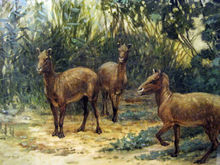Historical evidence shows that the domesticated horse is the result of centuries of evolution. The mammal known as the Eohippus began browsing on live shoots and tree branches during the Eocene period. Scientists have documented this history through prehistoric animals to the modern horse.

Eohippus - Horse ancestor
Researchers concluded that the center toe compensated for the reduction of side toes and the larger bodies of the equine by becoming resistant to bending and stronger.
© Charles R. Knight-1905 painting
Stages of change lead to animals with larger bodies, an increased capacity to learn and other physical refinements with multiple toes becoming a single functional toe. Pads became hoofs and bones lengthened and fused to provide support and speed for the larger animal.
Researchers study, published in the Proceedings of the Royal Society B, lends support to existing hypotheses about the dramatic transformation in horses’ hoofs through history.
Digit reduction has been established as a major trend that in horse evolution, but its causes and consequences have not been quantitatively tested. Using methods of scientific study, researchers tested how leg bone stresses changed with reduction of digits or toes as the animals increased in body size across the horse lineage.
Researchers used internal bone geometry from 13 fossil horse genera that covered the breadth of the equid history and the spectrum of digit reduction and body sizes, from the Hyracotherium to Equus.
To account for the load-bearing role of side digits, a novel, continuous measure of digit reduction was also established—toe reduction index. Study results showed that without accounting for side digits, a three-toed horse as late as the animal known as Parahippus would have experienced physiologically untenable bone stresses.
Conversely, when side digits are modelled as load-bearing, species at the base of the horse radiation through Equus probably maintained a similar safety factor to fracture stress. Researchers concluded that the center toe compensated for the digit reduction of the side toes and the larger bodies of the equine by becoming more resistant to bending and stronger as the center digit evolved into the hoof of the modern horse.
These results lend support to two historical hypotheses: that increasing body mass selected for a single, robust middle toel rather than several smaller ones; and that, as horse limbs became elongated, and the side toes gradually lost their stabilization or load-bearing strengths leading to the hoofs of modern domesticated horses.
